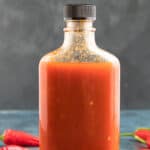Homemade Sriracha Sauce Recipe
This homemade sriracha sauce recipe is more like the original Thai recipe, so much better than anything from the grocery store, and can be made with fresh or fermented peppers. Time to make sriracha hot sauce!
Servings: 64 tablespoons
Calories: 9kcal
Ingredients
FOR FERMENTED SRIRACHA SAUCE
- 2 pounds mixed red chili peppers (red jalapenos are preferred, though Fresnos or red Thai peppers are great)
- 4 cups unchlorinated water
- 3 tablespoons sea salt
- 4 cloves garlic chopped
- 1 tablespoon light brown sugar (or more to taste)
- 1 teaspoon granulated sugar
- 1 cup rice wine vinegar
SRIRACHA SAUCE WITH FRESH PEPPERS
- 2 pounds mixed red chili peppers (red jalapenos are preferred, though Fresnos or red Thai peppers are great)
- 1/2-4 cups unchlorinated water (Use only 1/2 cup for a thicker sriracha sauce. Use 4 cups for a much thinner sriracha, which is more traditional)
- 4 cloves garlic chopped
- 1 tablespoon light brown sugar (or more to taste)
- 1 teaspoon granulated sugar
- 1 cup rice wine vinegar
- 1 teaspoon sea salt (or to taste)
Instructions
FERMENTED SRIRACHA SAUCE
- First, ferment the chili peppers. Process your fresh peppers in a food processor. If you don’t have a processor, use a mortar and pestle or simply finely chop them. Pack them into a jar, leaving at least 1 inch of head space. The peppers may rise a bit when fermenting.
- Next, mix 1 quart unchlorinated water with 3 tablespoons sea salt. Pour just enough brine over the peppers to cover them, pressing them down a bit as you go. It is important to keep the peppers covered with brine to avoid spoilage. Check this daily.
- Screw on the lid and set the jar away from direct sunlight to ferment for at least 1 week. Ideal temperatures are between 55-75 degrees F. The most active fermentation period is between 1-2 weeks, so be sure to monitor it during this time. “Burp” the jars often by unscrewing the lid a bit to let out some of the accumulating gases - watch out for splatter. Or, use an airlock or membrane for easier fermenting. The peppers must be submerged beneath the water to avoid mold growth. If the peppers aren't submerged, they might not ferment properly.
- After 1-2 weeks, the fermenting activity will diminish and the brine will turn cloudy and taste acidic.
- Strain the fermented peppers but retain the brine. Add the peppers to a large pot along with garlic, brown sugar, granulated sugar and vinegar. Add 1 cup of the brine PLUS 1/2-3 cups fresh water, depending on desired thickness (see Notes). Bring to a boil. Reduce heat and simmer for 5-10 minutes to let the flavors meld.
- Cool slightly then add to a food processor or blender and process until smooth.
- Strain the mixture through a fine mesh strainer to remove the solids, if desired. Pour into hot sauce bottles and enjoy.
SRIRACHA SAUCE WITH FRESH PEPPERS
- Roughly chop the chili peppers and add them to a pot with the remaining ingredients.
- Bring to a quick boil, then reduce heat and simmer for 15 minutes.
- Cool, then add to a food processor or blender. Process until smooth.
- Strain the solids out through a fine mesh strainer, if desired, and discard (or keep them for dehydrating – they make great seasonings). Pour into bottles and use as desired.
Notes
Makes about 4 cups of sriracha.
Brine. For a thicker sriracha, use only 1/2 to 1 cup of the water or brine when simmering. Use the full amount for a much thinner version, which is more traditional. You can use all of the brine in lieu of fresh water after fermenting, but the brine is quite salty.
For storage: Vinegar affects acidity levels. Homemade sauces should be kept at 4.0 pH or below to keep longer term. Use pH strips or a pH meter. If your hot sauce is not acidic enough, add more vinegar to lower the pH. Keep in the fridge for freshness and longer keeping. You can also bottle your sauces with proper procedures.
Heat Level: Medium.
Nutrition
Calories: 9kcal | Carbohydrates: 2g | Protein: 1g | Fat: 1g | Saturated Fat: 1g | Polyunsaturated Fat: 1g | Monounsaturated Fat: 1g | Sodium: 329mg | Potassium: 50mg | Fiber: 1g | Sugar: 1g | Vitamin A: 167IU | Vitamin C: 34mg | Calcium: 4mg | Iron: 1mg
